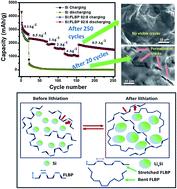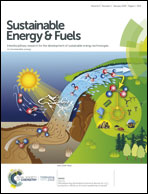High capacity, power density and cycling stability of silicon Li-ion battery anodes with a few layer black phosphorus additive†
Abstract
The exceptionally high theoretical capacity of silicon as a Li-ion battery anode material (4200 mA h g−1) is hard to realize and stabilize in practice due to its huge (300%) volume changes during lithiation/de-lithiation. The design, constitution, and microstructure of the anode hold the key to a desired potential solution. Towards this end, herein we exploit the very high flexibility of few layer black phosphorus (FLBP), far exceeding that of most of the carbon forms extensively studied thus far, attributed to its typical puckered structure and low Young's modulus, to realize an exceptionally high capacity, power density and stability Si nanoparticle based anode design. Our process employs a simple physical mixture of silicon nanoparticles (SiNPs) and chemically exfoliated few layer black phosphorus (FLBP), which is simple and easily scalable. Very high capacity values reaching 3386 mA h g−1 and 2331 mA h g−1 at current densities of 0.1 A g−1 and 0.5 A g−1, respectively, are obtained with impressive stability measured up to 250 cycles.



 Please wait while we load your content...
Please wait while we load your content...